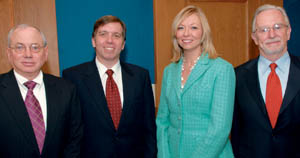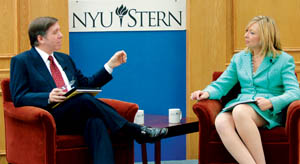David Lieberman: You're the umpire for a $70 billion dollar business – television advertising – at a time when the baselines are all changing. So I want to start off with some questions that may seem ridiculously simple. From your point of view, what is
television today?
Susan Whiting: A few years ago the answer was pretty straightforward. But that's changed. And you just have to look at what happened with the Super Bowl commercials. Ads bought for one of the biggest events of the television year now get a lot of exposure on websites. So I think we've morphed from the television in the home, to the PC, to your cell phone, to your video iPod, and wherever the TV content ends up.
DL: Next, what is a television viewer? In my office, just about everyone has a television set on, but the sound will be off and we're not watching. Are we viewers?
SW: Nielsen ratings show the viewing estimate from the sample of homes that we measure. It is not at your office; it is not, today, a hand-held device, although it will be. Most of the methods we use require an audio code to determine whether the program is on. So if you have the sound off, it wouldn't be picked up.
DL: Do you know who's watching?
SW: Our People Meter service puts a meter on each TV set, and it tells us what channel you're tuned to and for how long. But it doesn't tell us who is in front of the television set. And since most advertising is targeted by demographics, you need the who. We measure that in a couple of ways. The People Meter has a button for each person in the home, so we can monitor who within a particular household is watching what. That's how we get demographic ratings.
DL: Last night, my family watched "American Idol” and obviously somebody paid for the glasses of Coca-Cola to be on the judges' desk. Is that an advertisement?
“I think we've morphed from the television in the home to the PC, to your cell phone, to your video iPod and wherever the TV ends up.” |
SW: Absolutely. We have much more fragmented attention, because digital video recorders (DVRs) allow people to skip through things. Advertisers still need a way to reach their audience, and so they're looking back in time to sponsorship of whole programs. We measure product placement.
DL: Advertisers in the past sprayed their ads all over and prayed that they would reach the target market. But now, television is becoming a lot more intelligent and accurate with audience measurements. Why will they need you to sample if they can find out precisely how many people are watching their shows?
SW: If you are an advertiser or a manufacturer with a website, you know all about the traffic to your site. But you don't know about the activity on your competitors' sites, or what the people who visit your site are doing with the rest of their time. And these are all things you need to know in order to build your business and market. That's the advantage of having panels that go across the industry or business. Also, you don't generally know who is coming to your site. And so by collecting a sample of people and measuring their behavior, you can select their demographic. Finally, there's independence. A lot of the advertising support in media needs to prove to advertisers that they've spent their money well. And for that, you need an independent measure.
DL: I know you've been spending a lot of time recently looking at DVRs. And there seems to be still a bit of controversy as to how much advertising people really watch when they watch a recorded show. What are you finding?
SW: About 7 percent of the country has DVRs right now. We just started our national panel measuring them at the end of December, so we don't have a lot of data. But we see that young men and women, 18- to 34-year-olds, in particular, use them more. People are watching their favorite programs more. So the ratings of a program actually increase when you look at the people who watch within the next 24 hours or seven days.
DL: What's the difference between the People Meter and the new local People Meter?
“I never set out to be the CEO of a company. I wanted an interesting job where I could travel. I was an economics major and so what we did at Nielsen made sense to me, because it was all about trends, demographics, and marketing.” |
SW: It's the same technology. When you see a Nielsen rating in USA Today it's generally the rating from our national panel of homes. But we took the technology we've used for 20 years nationally, and brought it into the top 10 cities in the country. And the People Meters replace the diaries, where we used to compile ratings by charting what people said they watch.
DL: When the local People Meters began to come out, everyone from Al Sharpton to Rupert Murdoch criticized them. The fear was that new technology would undercount the number of minority viewers in particular. Where do you stand with that?
SW: We've put the People Meters in nine of the top 10 markets, so we have a lot of information about the transition. And in fact, in almost every market where we've introduced the People Meters, we've actually seen much higher viewing levels among African-Americans, Hispanics, and Asian-Americans. People weren't remembering everything that they were watching, and they weren't writing it all down.
DL: I think that probably a lot of people in the audience would like eventually to become CEOs. Is this something you've always wanted to be?
SW: I never set out to be the CEO of a company. I wanted an interesting job where I could travel. I was an economics major and so what we did at Nielsen made sense to me, because it was about trends, demographics, and marketing. And I love building businesses. I think I finally thought it might be possible to be CEO when I reached the general manager position, which is someone who basically runs half the company.
DL: Did you have to change your life at that point?

Above, from left to right: Deputy Dean Russell Winer, David Lieberman, Susan Whiting, and Dean Thomas Cooley.
Below: David Lieberman interviews Susan Whiting.

|
SW: It really is a seven-day-a-week job. I don't care what anybody says. Even if you're not at work, you're thinking about it. I have to go a long way away to turn it off.
DL: Would you say that your experience was typical or atypical to the other CEOs that you know?
SW: I think it's probably fairly typical. You become known for building businesses, which is a lot of what I did for Nielsen, or you become known for turning around businesses. But it's unusual to be at one company for 27 years, so I know that's different. It gives me a great, great perspective, and in some ways it makes it easier for me to change the company. I think there's a certain level of trust you get because you've been there for a while.
DL: Is there any advice you'd give for people who might be graduating and starting off in their career?
SW: You want to find an area that you're interested in, that you have some passion and feeling about. It's a lot easier to go to work every day if you're doing something you're interested in. You need to work with people you respect. The way you find many good jobs is by asking everybody you know about what they do, until something clicks. But you better ask a lot of questions.
DL: And are we still in an era where it's harder for women to go up the corporate ladder, or has that changed?
SW: I think it's still harder, although I think it's much, much better than when I started working. Our company is very, very diverse, and I honestly can say that for the last 10 years I didn't even think about it. But I still will often go into board or client situations where I'm the only woman in the room.
Audience Questions:
Q: Are you researching the measurement of consumer-driven initiatives, such as interactive marketing programs?
SW: We just invested in a company called BuzzMetric, which uses the Web and publicly displayed information and examines word-of-mouth on programs and products. Will that be the way an advertiser values an ad? Not directly. But it will tell people something about opinions and thoughts about programs and other things.
Q: You said that it's going to take you quite a bit of time to launch this People Meter across 200 cities. Are you worried that somebody might roll out a similar technology more quickly?
SW: A big part of the reason we don't have People Meters in all markets is the economics. We measure markets with a population of 20,000. So it's hard to imagine how these smaller markets would support the type of expensive but higher-value service we use in the big cities. We feel we have to offer a service that our clients can afford to use, and they could not afford People Meter service in 200 markets. Also, technology by itself will never win the day.
Q: In 1965, a TV advertiser could reach 80 percent of the US population with three prime time ads. Today it would take between 100 and 200 ads. What is Nielsen doing to facilitate, assist, and advise advertisers on how they can improve advertising effectiveness in this changing world?
SW: We do things like retention analyses – we'll look at how the viewers stay or didn't stay through certain commercials. We're announcing a set of studies of what we call Engagement, where we'll re-contact and re-interview homes that are in a panel. This is where we're starting to work directly with advertisers, because traditionally, in our business model, we work with their ad agencies.
Q: As advertising methods change, one method coming about now is more emphasis on point-of-purchase promotions, and in-store video. How do you think that's affecting Nielsen's business?
SW: We're actually measuring things like Wal-Mart TV and other place-based media because it is really important if you're a major advertiser to understand that. We have a growing business in sports stadiums and other places. Basically, we know we have to measure wherever the advertising is.


![]()